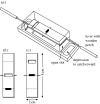The tale of the finch: adaptive radiation and behavioural flexibility
- PMID: 20194172
- PMCID: PMC2830236
- DOI: 10.1098/rstb.2009.0291
The tale of the finch: adaptive radiation and behavioural flexibility
Abstract
Darwin's finches are a classic example of adaptive radiation. The ecological diversity of the Galápagos in part explains that radiation, but the fact that other founder species did not radiate suggests that other factors are also important. One hypothesis attempting to identify the extra factor is the flexible stem hypothesis, connecting individual adaptability to species richness. According to this hypothesis, the ancestral finches were flexible and therefore able to adapt to the new and harsh environment they encountered by exploiting new food types and developing new foraging techniques. Phenotypic variation was initially mediated by learning, but genetic accommodation entrenched differences and supplemented them with morphological adaptations. This process subsequently led to diversification and speciation of the Darwin's finches. Their current behaviour is consistent with this hypothesis as these birds use unusual resources by extraordinary means. In this paper, we identify cognitive capacities on which flexibility and innovation depend. The flexible stem hypothesis predicts that we will find high levels of these capacities in all species of Darwin's finches (not just those using innovative techniques). Here, we test that prediction, and find that while most of our data are in line with the flexible stem hypothesis, some are in tension with it.
Figures
References
-
- Ancel L. W.1999A quantitative model of the Simpson–Baldwin effect. J. Theor. Biol. 196, 197–209 (doi:10.1006/jtbi.1998.0833) - DOI - PubMed
-
- Arbogast B. S., Drovetski R. L., Curry R. L., Boag P. T., Seutin G., Grant P. R., Grant B. R.2006The origin and diversification of Galápagos mockingbirds. Evolution 60, 370–382 (doi:10.1111/j.0014-3820.2006.tb01113.x) - DOI - PubMed
-
- Avital E., Jablonka E.2000Animal traditions: behavioural inheritance in evolution Cambridge, UK: Cambridge University Press - PubMed
-
- Bateson P.2004The active role of behaviour in evolution. Biol. Philos. 19, 283–298 (doi:10.1023/B:BIPH.0000024468.12161.83) - DOI
-
- Bolmer J. L., Kimball N. K., Whiteman J. H., Sarasola J. H., Parker P. G.2006Phylogeography of the Galápagos hawk (Buteo galapagoensis): a recent arrival to the Galápagos Islands. Mol. Phylogenet. Evol. 39, 237–247 (doi:10.1016/j.ympev.2005.11.014) - DOI - PubMed
Publication types
MeSH terms
Grants and funding
LinkOut - more resources
Full Text Sources


